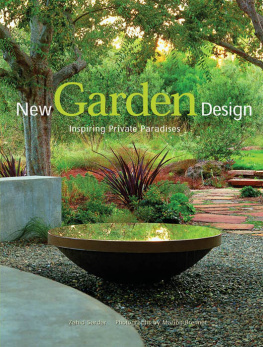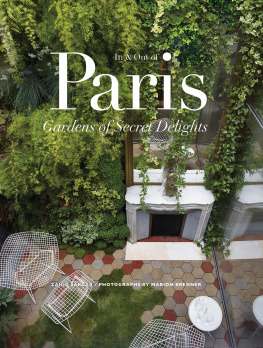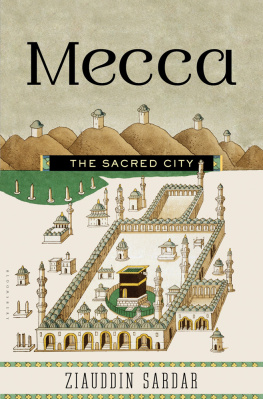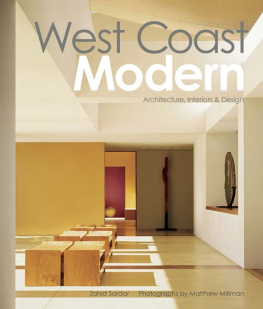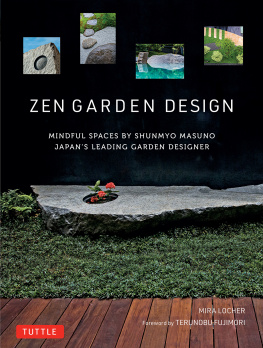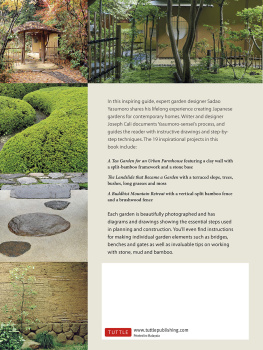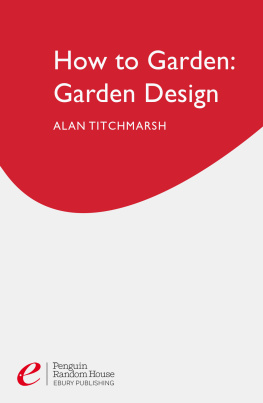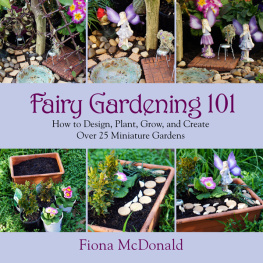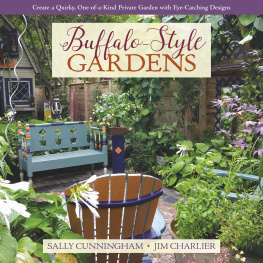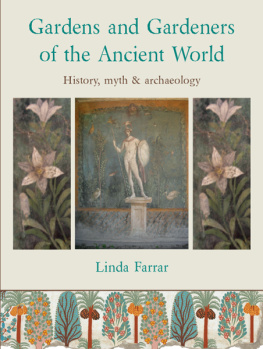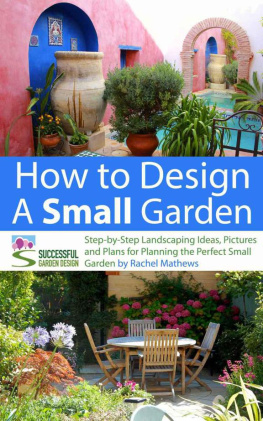With heartfelt thanks to friends, designers and home owners who have graciously shared their work and to our friends: Alta Tingle of the Gardener, Flora Grubb and Jason Dewees of Flora Grubb Gardens, Antonia Adezio and Betsy Flack of The Garden Conservancy, and the Strybing Arboretum in San Francisco. Special thanks to Kelly Macy for her generous advice.
Introduction
The First Gardens
Garden design has evolved from rudimentary farming into an art form, thanks to serendipitous juxtapositions of cultures, grafted one upon the other. While no one can tell conclusively where the first cultivated garden was, more than likely it was in the arid Middle East where most of the worlds oldest civilizations began, and today, new garden designs still reflect their seminal form.
To imagine that form, flash back 4,000 years to the oases gardens of desert nomads and to towns that preceded Judeo/Christian and Islamic societies. There, discover the roots of Paradisethe ancient Persian pairidaeza (walled garden) and a rectangular walled park, or firdaus , where nobles hunted amid springs, orchards and gardens stocked with wildlife, protected from storms and maraudersand glimpse the genesis of ancient Greek, Roman and modern American gardens.

At her Berkeley home and gallery garden, artist Marcia Donahue incorporates found objects, gravestones and stone sculpture of her own making that echoes ancient works in the Easter Islands.
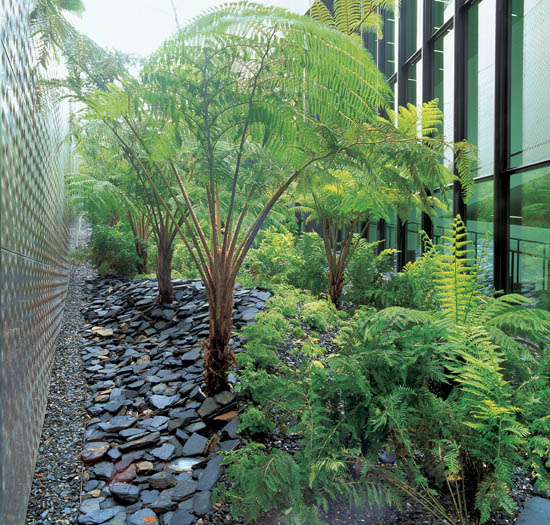
At the new de Young Museum in San Francisco, which was built over former sand dunes, landscape architect Walter Hood has created a biblical garden of tree ferns and shattered or crushed shaleto suggest how the sand on the site was probably created over time.
Taming natureattractive, yet dangerousis one way to be closer to it and gardeners from antiquity to today, in Greek topias , farms, or contemporary urban backyards, have been transfixed by the idea. Its a small wonder that gardens play a key role in stories of the oldest religions. In the desert, a paradise garden was akin to heaven.
The well-watered garden was a symbol of life, peace and prosperity. Hydraulic systems mastered by Mesopotamians, Persians and Assyrians to feed orchards and fountains on higher ground near river marshes, and ancient Egyptian rooftop gardens, distinctive peristyle colonnaded courtyards, and water gardens stocked with fish and fowl for the afterlife along the Nile, all influenced the Greeks.
In 332 BC when Alexander the Great ventured into Egypt from Macedonia, founding Alexandria, and then east to India, he was exposed along the way to elaborate Persian and Assyrian versions of enclosed outdoor space. Although he died far from home in 323 BC, his armies returned with new plants (such as tulsi , basil from India) and ideas for gardens with hydraulic irrigation that the Greeks emulated. Paradeisos , hunting parks and outdoor shrines with statues of deities under shelters (like tents in oases), evolved into open pavilions and covered temple buildings in gardens.
Walled Roman pleasure gardens with frescoes, such as those preserved at Pompeii, show how the Greeks before them must have tried to shape their sacred parks and gardens. Kitchen gardens, we learn from ancient chroniclers, were within paved open-to-sky courts outside a one-room house and may have had potted herbs and plants, while horticultural space for vegetables and flowers grown in the ground was usually within shouting distance of the town gate.
Vitruviuss writings circa 27 BC are the oldest surviving manual on design, and his adage about buildings that must have durability, utility and delight can be extended to enclosed outdoor space. When volcanic ash from Mount Vesuvius buried Pompeii and Herculaneum in AD 79, it also took the life of Pliny the Elder whose writings best depict Roman garden concepts. He died in the tragedy that has also miraculously preserved one of antiquitys garden cities, but his words and Vitruviuss treatise bring to life what remains of Pompeii and other such Mediterranean garden sites.
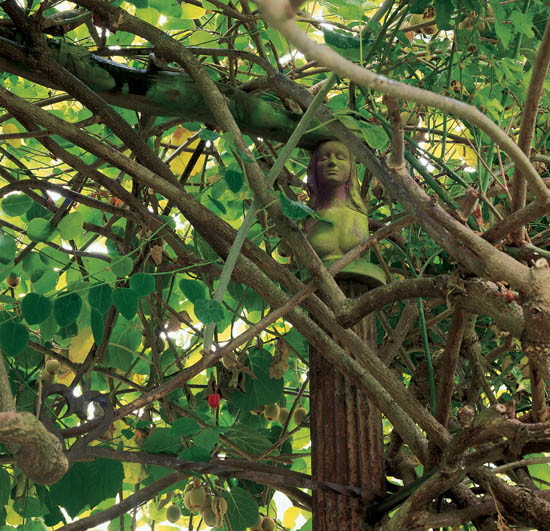
No examples of paintings or frescoes of pre-Hellenistic gardens in Greece have survived to tell us more about their affinity for nature, but artist Marcia Donahue is familiar with stories that describe them and draws inspiration from them to create her own temples to Greek and Roman goddesses. Amid the tangled thicket of Donahues gallery garden, where the public is invited in, she has many statues of the goddess Flora whose bust, shown here, props up a tree limb.
Emperor Hadrians AD 130 villa garden outside Rome showed eclectic ideas from areas of the world he had visited, including lavish use of water in the Egyptian style. It had grottos, canals and pools, enclosed domestic gardens and open courtly spaces, and theaters for public gatherings all arranged to take advantage of the location. Classical gardens typically relied on prescribed forms that made Hadrians innovations a better model for many adventurous mannerist Italian, French and Mediterranean gardens built after the villa was rediscovered during the Renaissance. At the 1550 Villa dEste in Tivoli, where cascading fountains are fed by the river Aniene, statuary was literally lifted from Hadrians estate. Twentieth-century Hearst Castle in San Simeon by architect Julia Morgan owes a debt to Hadrians design.
The classic charbagh (quartered garden) of Islamic palaces and tombs, which came to represent paradise or heaven, can be seen in its developed stage at the Taj Mahal, built by the Mughal emperors of India. Their fragrant gardens were the zenith of the ancient rectangular walled compound form divided into four squares by two intersecting rills or channels of water running the length and breadth of the garden with a sacred pavilion in the center. Indigenous Indian versions of the quartered garden, planted as a mandala per Hindu Vastu tradition, were dedicated to fire, water, earth and ether, and, with each caravan along the Silk Route passing through India, these formal and metaphysical garden notions seeped into Europe during the Middle Ages.
Medieval cloisters and churches became laboratories for herbal remedies and healing gardens laid out in parterres where the mythic and medicinal properties of ivy, myrtle, olive, pomegranate and rosemaryubiquitous in cultic Greek gardens dedicated to Aphrodite or Artemiswere better understood. Add to that the Moorish taste for tiled, inward-looking, water-filled gardens with few but fragrant plants in Spain under Ottoman rule, and you have a view of the first Euro/American West Coast gardens that came north from Spanish Mexico. Just 200 years ago Christian missionaries from San Diego to San Francisco were planting practical four-square paradise gardens in walled courtyards with stone fonts in the center.

